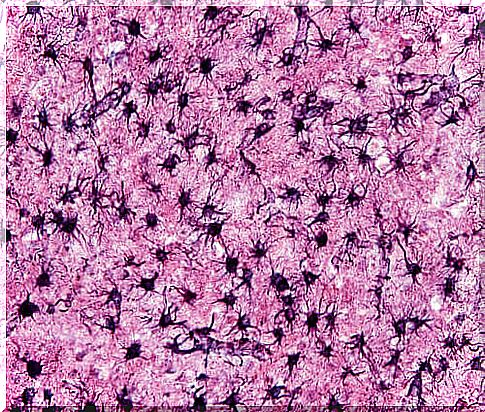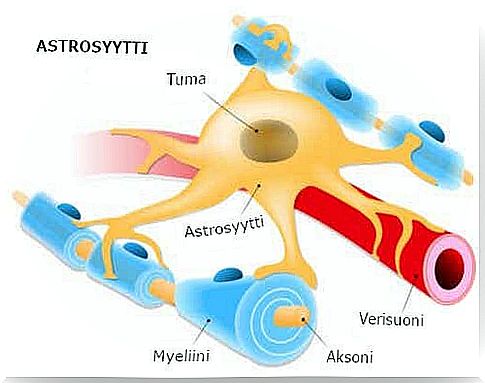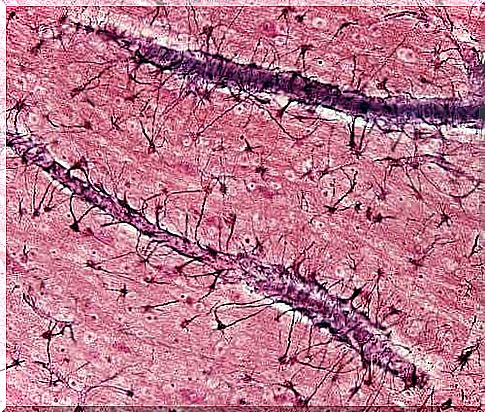Astrocytes: Nerve Pathway Builders

Astrocytes belong to glial cells, or nerve support cells. In the past, their importance was underestimated, as all attention was given to neurons, or neurons. However, it has since been shown that astrocytes do not only have a passive function, i.e. they only have a role in supporting neurons.
These types of glial cells are responsible for building nerve pathways and other functions such as:
- Nerve cell guidance during migration.
- Formation of cerebral blood barrier.
- Supporting neuronal metabolism.
- Participation in the creation of neurons.
So there is a lot to do with astrocytes that is worth knowing. For example, it is surprising how they respond to nerve cell function, repair themselves, and communicate with each other. Let’s take a closer look at the subject.

Various astrocytes
Astrocytes completely surround the capillaries of the brain and form a physical barrier between the blood and nerve cells. There are different types of astrocytes:
- Protoplasmic astrocytes. Located in gray matter. They are round and have branches that extend to other, irregular and curved branches. The ends of the branches cover the blood vessels, the surface of the meninges, and the synapses.
- Fibrous astrocytes. Located in white matter. They are long, thin and unbranched, fibrous in shape. Their ends intertwine with the Ranvier constrictions and blood vessels of the axons.
An interesting fact is that the name astrocyte comes from the shape of these cells: it resembles a star with protrusions that cover adjacent cells.
There is a protein in the cytoskeleton of astrocytes, called the glial fibrillar acidic protein. This feature is only found in astrocytes, which distinguishes them from other cells.
Tasks
Astrocytes build nerve pathways to transport information in the brain. Thanks to the neuronal connections they provide, their job is to help control the direction of axons through molecules that attract or reject.
As good builders, astrocytes know what’s going on in the nervous system at some point. For this reason, their function is to maintain the balance of neurons, i.e., homeostasis of the brain (hence, they are said to act as a support for metabolism), which is achieved by maintaining the ionic balance of neurons.
In addition, astrocytes are involved in the formation and maintenance of neuronal synapses. Through astrocytes, nerve cells receive oxygen, nutrients and protective insulation.
Through a process known as phagocytosis, these cells are able to destroy the waste products of the brain’s metabolism. This is a useful process as it allows for the disposal of waste and pathogens by transporting the waste products into the bloodstream for disposal. In the event of damage, astrocytes travel to the site of damage to destroy the dead neurons.
On the other hand, they are also part of a very important blood-brain barrier, making them messengers between the circulatory system and nerve cells as a filtering mechanism. They also play a role in regulating the transport of molecules from the blood to the brain.
Astrocytes are associated with neurotransmitters because they react actively with them and have receptors that associate with the neurotransmitters. This real way that astrocytes communicate is complemented by another way of sending messages: isolating synapses from each other and acting as a modulator of signals between neurons.
Astrocytes and reactive gliosis
There is a pathological process in which astrocytes multiply rapidly and unreasonably. This process occurs alongside inflammatory phenomena and is called reactive gliosis.
Researchers have found two types of astrocytes when they proliferate in this way: A2, which has corrective functions, and A1, which cause nerve tissue to break down.
Reactive gliosis occurs when there is damage to the nervous system followed by an increase in astrocytes in the area of damage. This phenomenon has been shown by many studies.

What are the benefits and why is it harmful?
Reactive gliosis is a beneficial phenomenon because it gives rise to the synthesis of neurotrophic factors responsible for neuronal survival. On the other hand, it is harmful because it creates a glial horn that inhibits the growth of axons.
This phenomenon is very important in clinical trials as it gives hope for new therapies. For example, experts are studying stem cell transplants utilizing neurotrophic factors that promote neuronal regeneration. Studies are being done to find cures for neurodegenerative diseases such as Alzheimer’s and Parkinson’s.
Why are astrocytes great builders of the nervous system?
The role of astrocytes is to establish communication links between different cells of the nervous system. And because they also have the task of isolating and removing harmful substances, in the event of brain damage, they allow these communication pathways to be rebuilt.
Astrocytes are able to make connections between different regions and anatomical-functional elements. These include the circulatory system and the blood-brain barrier, as well as neurons with each other and with brain neurotransmitters. In addition, they have an exceptional ability to maintain nerve pathways, as they maintain the internal balance of the nervous system.
In light of all these findings, we hope that neuroscience will continue to support these cells and the opportunities they bring to science.









